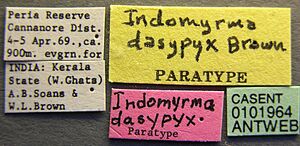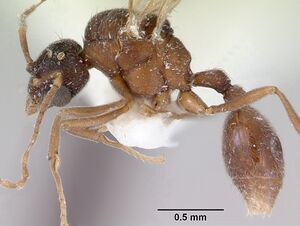Indomyrma dasypyx
| Indomyrma dasypyx | |
|---|---|

| |
| Scientific classification | |
| Kingdom: | Animalia |
| Phylum: | Arthropoda |
| Class: | Insecta |
| Order: | Hymenoptera |
| Family: | Formicidae |
| Subfamily: | Myrmicinae |
| Tribe: | Crematogastrini |
| Genus: | Indomyrma |
| Species: | I. dasypyx |
| Binomial name | |
| Indomyrma dasypyx Brown, 1986 | |
Known only from a few collections, the types were fortunately collected as whole colonies. These colonies were placed in artificial nests, observed over time, and details of their behavior published as part of the species description (see biology section below).
Photo Gallery
Identification
Zryanin (2012) - Indomyrma dasypyx can be distinguished from the only other species in the genus, Indomyrma dasypyx, by the number of ommatidia in worker, 2-3 in latter and 8-10 in the former. In worker and queen I. bellae distinguished from those of I. dasypyx in absence of subacute humeral angles, shape of petiolar node with rounded anterior edge, strong development of torose sculpture on head, alitrunk, petiole and postpetiole, foveolate or punctate sculpture at base of gaster and different character of pilosity (reduction of longer erect and suberect hairs).
Distribution
Latitudinal Distribution Pattern
Latitudinal Range: 12.498947° to 11.416667°.
| North Temperate |
North Subtropical |
Tropical | South Subtropical |
South Temperate |
- Source: AntMaps
Distribution based on Regional Taxon Lists
Oriental Region: India (type locality).
Distribution based on AntMaps
Distribution based on AntWeb specimens
Check data from AntWeb
Countries Occupied
| Number of countries occupied by this species based on AntWiki Regional Taxon Lists. In general, fewer countries occupied indicates a narrower range, while more countries indicates a more widespread species. |

|
Estimated Abundance
| Relative abundance based on number of AntMaps records per species (this species within the purple bar). Fewer records (to the left) indicates a less abundant/encountered species while more records (to the right) indicates more abundant/encountered species. |

|
Biology
Brown (1986):
Colonies were collected from from rotten logs in semideciduous forest.
Colonies from Kerala were estimated to contain between 100 and 500 workers plus copious brood in all stages of development. At the time of collection, all Kerala (April) nests contained some sexual brood, both males and queens together. Two colonies, M-238 and M-190, were kept alive for observation and rearing (Crozier's slide notation AABW-1 refers to nest M-238), and these were still eclosing a few winged forms in mid-May 1969 in a plaster-bottomed observation nest in the laboratory. The prepupal and male pupal tissue preparations for karyotyping were made during this period by Dr. Ross Crozier and myself, using his acetic acid, air-drying method (modified slightly; see Imai et al. 1977).
In the artificial nests, the ants were rather sluggish, and many entered into a death-feigning “pupal” pose upon the slightest physical disturbance. The workers and nest queens usually clustered thickly on the single, compact brood pile, virtually hiding it from view, in the manner of Myrmecina and some other small myrmicines, but in their natural nests in the field in India, the ants were found to be somewhat more dispersed in several definite chambers within good-sized pieces of rotten wood.
Within the artificial nest, Indomyrma workers accepted freshly killed, dismembered, housefly and scarabaeid beetle larvae, and live but disabled adult chironomids and mosquitoes, and fed them to at least the larger ant larvae directly. No ants were attracted to small droplets of diluted honey placed on tiny squares of waxpaper in one artificial nest, but these trials were very limited, and should not be taken as conclusive that the ants always ignore sweet substances. One peculiar habit, already alluded to in the descriptive section above (see male description, Indomyrma), is the worker transport of callow and fully pigmented adult males by means of the “antennal handles.” The peculiarly deformed male antennae (Figs. 13, 14) together form a curved, sublyriform handle or rack extending from the head forward. These are grasped in the worker mandibles, whereupon the transported male folds up his legs and remains motionless while he is being carried backwards, his rigid body often slanting upwards, to the new place where he will be set down. The worker mandibles appear to close upon that part of the male antennae where the most conspicuous modification (constriction) occurs (Fig. 14).
The four Kerala colonies observed first-hand appeared to be monogynous, that is, with only one dealate, deeply pigmented queen in each nest, but of course other functional queens may have escaped observation or capture during the confusion of collection.
Morphology
Malpighian tubules 5 in all castes, long, not cryptonephric (sample N = 1 queen, 4 males, 2 workers).
Genetics
Karyotype haploid number is 12 metacentric chromosomes, counted from 11 spreads from male pupal testes (Fig. 19), 15 spreads form prepupal brain of another male (Fig. 20) and two diploid spreads from the brain of a queen prepupa (Fig. 21 ), all from the cultured Peria Reserve (M-237) colony (see main biology section above). The slides were made by Dr. Ross Crozier and myself, and were stained, read and photographed by myself later.
Castes
Worker
Images from AntWeb
   
| |
| Worker. Specimen code casent0101964. Photographer April Nobile, uploaded by California Academy of Sciences. | Owned by MHNG, Geneva, Switzerland. |
   
| |
| Worker. Specimen code casent0172283. Photographer April Nobile, uploaded by California Academy of Sciences. | Owned by ANIC, Canberra, Australia. |
Queen
Images from AntWeb
    
| |
| Paratype of Indomyrma dasypyx. Queen (alate/dealate). Specimen code casent0172281. Photographer April Nobile, uploaded by California Academy of Sciences. | Owned by ANIC, Canberra, Australia. |
Male
Images from AntWeb
    
| |
| Male (alate). Specimen code casent0101922. Photographer April Nobile, uploaded by California Academy of Sciences. | Owned by MHNG, Geneva, Switzerland. |
    
| |
| Male (alate). Specimen code casent0172282. Photographer April Nobile, uploaded by California Academy of Sciences. | Owned by ANIC, Canberra, Australia. |
Nomenclature
The following information is derived from Barry Bolton's Online Catalogue of the Ants of the World.
- dasypyx. Indomyrma dasypyx Brown, 1986: 46, figs. 1-21 (w.q.m.l.k.) INDIA (Kerala, Karnataka).
- Type-material: holotype worker, paratype workers, paratype queens, paratype males (numbers not stated).
- Type-locality: holotype India: Kerala State (Western Ghats), Cannanore Dist., Peria Forest Reserve, ca 900 m., 4-5.iv.1969, nest no. M-242, rotten log (A.B. Soans & W.L. Brown); paratypes: with same data, paratypes with same data but nest nos M-237, M-238, paratypes Kerala State, Wynaad Taluk, Kottiyoor, ca 650 m., 7.iv.1969, nest no. M-190 (A.B. Soans & W.L. Brown), paratypes Mysore (= Karnataka) State, 8 mi. (13 km.) NE Mercara, 1000 m., 22.ii.1962 (E.S. Ross & D.Q. Cavagnaro).
- Type-depositories: MCZC (holotype); ANIC, BMNH, CASC, CUIC, MCZC, NZSI (paratypes).
- Status as species: Bolton, 1995b: 217; Bharti, Guénard, et al. 2016: 37.
- Distribution: India.
Unless otherwise noted the text for the remainder of this section is reported from the publication that includes the original description.
Description
- Brown 1986. Figures 1-21
Worker
Holotype: TL 3.4, HL 0.80, HW 0.67 (CI 84), ML 0.21 (MI 26), SL 0.56 (SI 84), EL 0.05, WL 0.97, hind femur L 0.65, hind tibiaL 0.50 mm. Paratypes: TL 3.3-3.6, HL 0.70-0.83, HW 0.58-0.72 (CI 83-87), ML 0.18-0.22 (MI 26-27), SL 0.49-0.57 (SI 85-79), EL 0.03-0.05, WL 0.86-1.00 mm.
Habitus, sculpture and pilosity are for the most part represented well in figs. 1-3, 6 and 9, plus the generic characterization. (Indomyrma)
Queen
Paratypes (alate and dealate): TL 3.8-4.0, HL 0.76-0.80, HW 0.66-0.70 (CI 87-88), ML 0.23 (MI 29-30), SL 0.55-0.56 (SI 80-83), EL 0.19-0.21, WL 1.10-1.12, forewing L 3.2-3.4 mm.
Aside from the more robust stature and usual full-queen differences from the workers (Figs. 4, 7, 10), the queen has slightly more distinct interfoveolar, longitudinal costae on the middorsal head, and some also on the mesonotum. Suberect hairs more numerous, especially on pterothoracic notum and gastric tergum. Color of fully pigmented individuals dark brownish red, darker on dorsum of head and alitrunk, where it is mahogany approaching black. Appendages yellowish brown.
Male
Paratypes: HW (without eyes) 0.47-0.51 mm in 8 specimens measured.
One representative specimen had TL 3.1, HL 0.57, HW 0.50, ML 0.16, SL 0.30, EL 0.26, WL 0.98, forewing L 2.8 mm.
Type Material
Types: Holotype worker, from nest no. M-242 (see below) deposited with some paratypes in the Museum of Comparative Zoology at Harvard University, Cambridge, Massachusetts 02138, USA. Additional paratypes (all adult castes) in British Museum (Natural History), London; Cornell University Insect Collection, Ithaca; Australian National Insect Collection, Canberra; Zoological Survey of India, Calcutta, and California Academy of Sciences, San Francisco.
Localities, all in peninsular India: KERALA State (Western Ghats), Cannanore District, Peria Forest Reserve, nests all in rotten logs in disturbed semideciduous forest at about 900 m elevation; M-242, M-237, M-238, 4-5 April1969, A.B. Soans and W.L. Brown, Jr. leg. Kottiyoor in Wynaad Taluk, rotten wood in evergreen forest at about 650 m, M-190, 7 April 1969, Soans and Brown leg. MYSORE State: 8 mi. (13 km) NE of Mercara, 1000 m, 22 Feb. 1962, E.S. Ross and D. Q. Cavagnaro leg.
References
- Brown, W. L., Jr. 1986 [1985]. Indomyrma dasypyx, new genus and species, a myrmicine ant from peninsular India (Hymenoptera: Formicidae). Isr. J. Entomol. 19: 37-49. (page 46, figs. 1-21 worker, queen, male described)
- Cantone S. 2018. Winged Ants, The queen. Dichotomous key to genera of winged female ants in the World. The Wings of Ants: morphological and systematic relationships (self-published).
References based on Global Ant Biodiversity Informatics
- Brown W. L., Jr. 1986. Indomyrma dasypyx, new genus and species, a myrmicine ant from peninsular India (Hymenoptera: Formicidae). Israel Journal of Entomology 19: 37-49.
- Dad J. M., S. A. Akbar, H. Bharti, and A. A. Wachkoo. 2019. Community structure and ant species diversity across select sites ofWestern Ghats, India. Acta Ecologica Sinica 39: 219–228.







